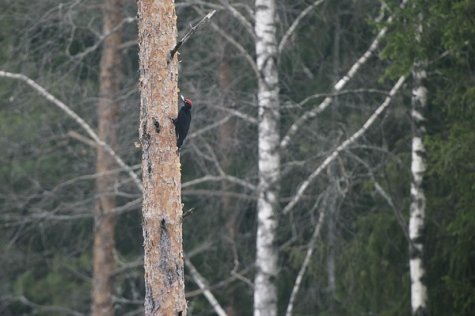Birder’s diary – summary of February
Birder: Margus Ots, linnuvaatleja.ee
Photo: Arne Ader
Translation: Liis
Black woodpecker
I made comparatively few trips in February, far from one each day. With the hard frost in the beginning of the month it was not particularly appealing to get out. But in the last February week the approaching spring could already be sensed – forests were full of woodpecker drumming in mornings, owls started to hoot and the first skylarks, lapwings and stock doves reached the western coasts. It did not yet turn warm enough however for any larger numbers of waterfowl to start arriving.
14 bird species were added in February to my year list, the total is now 119. Almost all the mandatory winter species have already been noted and since quite many early arrivals are on the list too (as individuals that stayed to winter), many more species will probably not be added in March. Of the traditional winter species only the twite is missing; this year only 2 observations are known from Estonia, but it is really much easier to find in late autumn. Instead I am beginning to get more concerned about the green woodpecker’s absence, because this species might really be disappearing in Estonia. Not a single individual was found in February in the quite thorough search of Saaremaa where it still occurs regularly. Early April trips will show if the green woodpecker nests at all in Estonia. Hopefully some pairs will still be found.
I haven’t been a particularly industrious winter points collector, but just to check I summed up all bird species from this winter (01.12.2011 – 29.02.2012) and the result was 131 species. Because December was very warm I collected winter points for a number of waders (e g greenshank, redshank, grey plover, sanderling, oystercatcher, ringed plover) and waterfowl (e g brent goose, pintail, shoveler), that are generally not encountered here in the winter months. Since no one-winter contest has been held earlier I can’t say at the moment if 131 species might be a record for species seen during one winter in Estonia? Had I known that a regular record was at hand I could actually have twitched a few more winter points. At least some ten relatively simple species could easily have been seen in December. But – I was not going to struggle for winter species, the aim is the whole calendar year result.
To be honest there has been quite a lot of hassle in the beginning of the year. Since many birdwatchers have asked how many trip kilometres and hours I have accumulated already, here they are: trip hours in January 154, and February 93 (major sea crossings time excluded), kilometres by car in January 5339 and in February 3544, kilometres on foot in January 146 and in February 42. With some regret I have to admit that there has been much driving around by car and maybe too little walking. But birdwatching is more about staying in one place than rambling around and probably the number of pedestrian kilometres will not increase in any drastic way. But I will try to drive less and have more time for watching. Days grow longer and many more watching hours will surely add up in April and particularly in May. And at the end of May, in the best period, there are sure to be some 24-hour days too.









